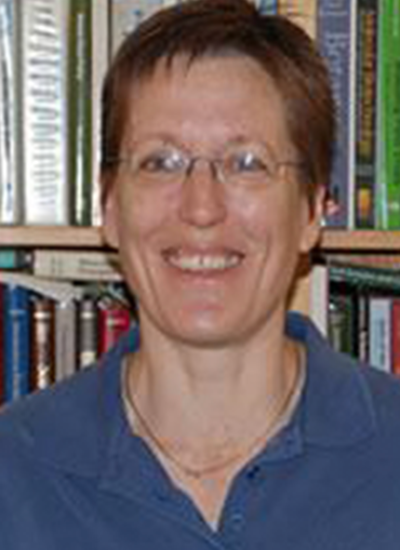Joan E Curry
Publications
Abstract:
Grand canonical ensemble Monte Carlo computer simulations have been used to study monolayer octamethylcyclotetrasiloxane (OMCTS) and cyclohexane films confined between mica-like surfaces to determine the effect of the mica surfaces on the orientation and distortion of the films at different surface alignments. The film molecules are packed as a highly ordered lattice. The orientation of the lattice is fixed relative to the mica surfaces and depends on the size of the film molecule. Registry shifts distort the film lattice by effectively stretching it along a particular direction that depends on the size of the film molecule. For a particular registry, OMCTS and cyclohexane monolayers are stretched in perpendicular directions. Coupling between the monolayers and the mica surfaces generates a nonzero shear stress when the surfaces are out of alignment, but the film does not become disordered or melt. It is possible that precisely controlled solid surfaces could be used to create packed arrays of film molecules with desired orientation and degree of distortion that may be useful in nanotechnological applications.
Abstract:
The grand canonical Monte Carlo method is used to study a binary mixture of Lennard-Jones atoms confined to various corrugated slit-micropores which are in thermodynamic equilibrium with their bulk phase counterpart. The micropore walls have the structure of the (100) face of an fcc lattice. In addition to this atomic scale structure, one wall possesses nanoscale structure in the form of rectilinear grooves (corrugation). The grooved surface divides the confined fluid film into two strip shaped regions. The confined film is studied in each region as a function of groove width, bulk phase composition, and the size of the wall atoms.
This research investigated activated adsorption of a hydrophobic organic contaminant(HOC) in mineral micropores using experimental and molecular modeling techniques. Adsorption of trichloroethylene (TCE) on a silica gel adsorbent was measured using a frontal analysis chromatography technique at atmospheric and elevated fluid pressures. Increasing the fluid pressure yielded increased TCE uptake that was not released upon lowering the pressure back to atmospheric conditions. This showed that the increase in pressure was able to rapidly induce the formation of a desorption-resistant fraction that previous investigations have shown requires months to develop at atmospheric pressure. Grand Canonical Monte Carlo (GCMC) modeling was then used to elucidate the nature of water and TCE behavior within silica micropores. The GCMC modeling showed that molecular scale packing restrictions resulted in pore fluid densities that ranged from 0.28 to 0.78 of those in the bulk solution. The modeling also showed that TCE was able to displace water from hydrophilic mineral pores due to molecular scale packing restrictions. Exothermic isosteric heats for TCE adsorption up to -27 kJ/mol were observed and were greatest in pores of 7 and 8 A. This indicated that TCE adsorption was energetically most favorable in pores that were minimally large enough to accommodate a TCE molecule. The pressure-induced uptake appeared to result primarily from an increase in the packing density in the smallest pores. Ab initio calculations showed that small distortions of a TCE molecule from its low energy conformation require high activation energies. Results from this study indicate that activated adsorption requiring bond angle distortions in the adsorbate may be responsible forthe slow attainment of adsorptive equilibrium of HOCs on microporous solids. Likewise, activated desorption from molecular-sized adsorption sites may contribute to the slow release of HOCs from aquifer sediments.
Abstract:
Here we present the work of the 2006 University of Arizona team in the iGEM (international Genetically Engineered Machine) competition sponsored by MIT. Our aim was to develop an inducible water colour system for painting bacteria in three colours. Using BioBricks, a plasmid was designed for insertion into E. coli which would allow the bacterium to respond to each of three different chemical inducers by producing yellow, cyan or red fluorescent proteins. In principle the inducers could be deposited on a bacterial lawn using a high-resolution printer so that three colour images could be produced with a spatial resolution matching the size of the bacterium. This could be the first step towards producing a bacterial lawn that behaves like a canvas for watercolour painting or eventually a three-colour television set. The application connects with current interest in precise control of cellular response desired in biosensors and bioengineered materials. The University of Arizona iGEM team called the 'Cell Raisers' was assembled in May 2006 and worked enthusiastically throughout the summer. The team was comprised of six undergraduates (Tyler Brown, Brian Heinze, Patrick Hollinger, Josh Kittleson, Kevin MacDow, and Dan Reavis), one graduate student (Carlos Chang), and two faculty members (Joan Curry and Mark Riley). This proved to be an ambitious project, and while the final goal was not fully realised, first steps were made in terms of design, plasmid construction and bacterial deposition with an inkjet printer. Patrick Hollinger and Brian Heinze gave the technical presentation to judges and competing teams on Saturday, November 4, 2006 in MIT's Stata Center. The team also presented a poster that was viewed in the evening after all the presentations. For their efforts, the University of Arizona team received honourable mention with special consideration: 'For progress toward synthetic biology in three colours'. © 2007 The Institution of Engineering and Technology.
Abstract:
The Gouy-Chapman theory is applied to a 1:1 electrolyte to show that the coion size is only important at surface charge densities much lower than those found in typical clay systems. Next the model is applied to a 1:1 and 2:1 electrolyte mixture with unequal-sized counterions to show the swelling pressure is highly dependent on both counterion sizes. -from Authors


